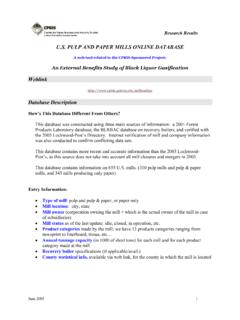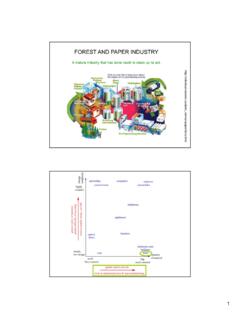Transcription of PULP, PAPER & FORESTRY INDUSTRY - ppsa.memberclicks.net
1 THE pulp AND PAPER SAFETY ASSOCIATION--- BRINGING THE INDUSTRY HOME SAFE 1 pulp , PAPER & FORESTRY INDUSTRY - A CALL TO ACTION HYPER FOCUS & MISUSE OF TOTAL RECORDABLE INCIDENT RATE (TRIR) It is with great enthusiasm that the pulp & PAPER Safety Association (PPSA) reach out to all our members, our INDUSTRY , and beyond for a Call to Action. For many decades the pulp and PAPER INDUSTRY has made great strides in improving safety results. The INDUSTRY safety journey has moved from a laissez faire approach, through focused compliance, prioritization, adopting a caring and values methodology and today - amidst a true understanding of science - a human organizational performance approach. Our efforts and successes have been immeasurable and many of us are on the cusp of greatness, but one critical challenge remains. There is a seemingly unshakeable obstacle that impacts all INDUSTRY - a self-induced barrier in how we use lagging metrics -our failures- to evaluate and compare our performance.
2 More specifically and certainly the worst is the use of the Total Recordable Incident Rate (TRIR) to grade, compare and incent not only our organizational performance, but the performance of individuals. Our INDUSTRY is not alone in this challenge. While a number of organizations within the pulp and PAPER INDUSTRY have moved past this barrier, the prevalent cloud of its past misuse remains ingrained in our culture. For those in the safety profession, the challenges faced regarding this very specific number have been daunting and exhausting to say the least. While it is recognized this regulatory measure provided useful statistical data to the Department of Labor, it is likely OSHA forefathers never anticipated the albatross the TRIR rate would become, or that it would become one of the most hijacked, misused, and manipulated statistic of all time. For safety professionals charged with interpreting a recordable injury, the statistic became one of the murkiest interpreted of all measures even though its criteria are very black and white.
3 One of the most disillusioning statistic in recent years is the false premise of what was believed to be an indicator of a strong safety performance .. the Holy Grail .. a sustained period of ZERO RECORDABLES. However, when analyzing site Serious Injury & Fatality (SIF) incidents, recent studies have identified no correlation in SIF occurrence between locations with low TRIR and those that experienced higher incident rates. Yes, you are reading that correctly .. over time, facilities that have zero or low incident rates are experiencing SIFs at a rate comparable to sites with higher TRIRs. This is significant in light of many of our organizational systems that focus attention and improvement methodologies on facilities with higher TRIR. By design, we have removed the focus from facilities with few or zero recordable incidents. In reality, instead of using TRIR to manage our safety efforts, we should be measuring a site s organizational capacity and the strength of their risk management systems.
4 Simply put, what we incent, grade, and compare MUST be our capacity and system strengths versus relying on our self-reported - OSHA mandated - documented failures. THE pulp AND PAPER SAFETY ASSOCIATION--- BRINGING THE INDUSTRY HOME SAFE 2 Let s test this philosophy with a comparison of how this data is commonly used today. Answer the following million-dollar question. Given organizations with similar population, risks, and resources, which of the following sites is safest when comparing their 2017 OSHA TRIR rate? Site A: TRIR Site B: TRIR Site C: TRIR If you believe the question is in fact a trick question, it may only be because this article has prepared you for what is a reality. It is simple to illustrate the influence and manipulation that occurs intentionally and unintentionally every day. For the purposes of this analysis, we are going to assume all three sites are not intentionally manipulating the numbers.
5 So, what is your answer? If you have been relying upon TRIR, as many have for the last decades, you will likely lean towards Site B as the best performing site in safety and Site A as the worst. This may appear obvious because the higher ratio of injuries to employee hours indicates more medical treatment is occurring at site A than B. If your answer is that you do not have enough information, you are on the right path to understanding the intent of this article. But for the consummate safety professional and thoughtful leader, the answer is very quickly the TRIR rate alone gives you little to no understanding of the site s safety performance capabilities. To understand why, let s look at some additional context about each site. Site A: TRIR In 2015, the site initiated and rolled out a comprehensive leadership approach using human organization performance methodology. Its primary goal was a reduction in SIFs and to identify precursors and eliminate high risk gaps.
6 The site only tracks TRIR for annual reporting purposes for OSHA. The site does not use TRIR for a goal, performance bonus, incentive, comparison, grade, or as a measure of safety excellence. Leaders view a soft tissue recordable that was caught early as a positive indicator, believing that an employee may receive medical treatment resulting in a recordable, but likely preventing a rotator cuff surgery in the future. In addition to an experienced and competent 20-year INDUSTRY safety professional, the site has a General Manager that experienced a site fatality early in his career after having a string of three years without a recordable incident. The site s key safety goals for 2017 were: Complete separation of powered industrial trucks and pedestrians in ALL areas of the site, not just allowing a focus on warehouse traffic. To accomplish this a site logistical study was conducted, engineering controls were put in where the two types of traffic overlap, significant management system improvements were implemented, and auditing of those systems is on-going.
7 A significant capital project kicked off modernizing the site s 40-year-old rewinder where countless SIFs had occurred sporadically over a four-decade period. Trend analysis indicated 50% of the injuries experienced were soft tissue related, so an Industrial Athletic Trainer was contracted to target early intervention, implement a proactive ergonomics focus, and conduct a significant amount of wellness training. THE pulp AND PAPER SAFETY ASSOCIATION--- BRINGING THE INDUSTRY HOME SAFE 3 The site had 6 recordable injuries. A back injury resulting in 16 lost days from an employee slipping down wet stairs. A hand laceration resulting in 3 stitches received from an unforeseen nail on a shipping container. Employee visited Athletic Trainer (AT) with soreness in lower back. AT provided cold/heat therapy and prescribed stretching exercises to expedite the recovery. Based on the exercise treatment the injury was a recordable.
8 An employee slipped and fell in the parking lot. Site leadership immediately took the employee to the doctor to be evaluated. X-rays indicated there were no breaks but to help reduce swelling, the doctor prescribed a 600 mg anti-inflammatory medication. The site had 400 mg over-the-counter (OTC) doses in their first aid room, but the site leaders long ago had abandoned the need to manage medical care or self-doctor. Instructions were not provided to persuade the doctor from giving prescriptions or a need to manage around an injury to avoid a recordable record. The fact that the employee was taking 600 mg of ibuprofen versus 400 mg had no impact on the root cause of the incident or the ability to prevent it. Site leadership did not believe that they knew better than a doctor on care management and to do so would be contrary to every mission, value statement or vision policy posted on conference room walls across their job site.
9 An employee visited the AT after being assigned a new job where they had to lift material above their head many times a shift. The employee spoke of moderate muscle pain in the shoulder and upper arms. The AT noticed that certain new muscles were being used and needed to be strengthened to help the employee avoid pain and tearing. The AT gave the employee resistance bands and showed the employee how to use the bands to strengthen their muscles required for the new task. The AT also gave OTC ibuprofen. Because the AT provided resistance bands, which equated to exercise instructions needed to strengthen and condition, the treatment was recorded because it was not on the OSHA list of first aid. An employee had an allergic reaction to a bee sting in the woodyard. The employee missed the next day of work to recover and to allow swelling and discomfort to go down. Site B: TRIR The site had two years without a recordable injury.
10 The site s safety professional was new, and the General Manager was very involved in the determination of recordable injuries. The General Manager required the safety professional to be in the exam room every time someone sought medical treatment. They had several workers compensation cases but would always manage to eliminate the need to record anything based on the General Manager s own interpretation of the recordkeeping requirements. The site has several key metrics around TRIR rates to include incentives for achieving zero recordable incidents within a department. The site provides a steak dinner for department teams that are able to work a year without a recordable incident. In 2016, the site presented jackets to all employees for experiencing a year with zero recordables. THE pulp AND PAPER SAFETY ASSOCIATION--- BRINGING THE INDUSTRY HOME SAFE 4 The site truly and sincerely shares a message that the company cares about employees and their efforts in safety are to drive injury free results and get their fellow workers back home safely.









